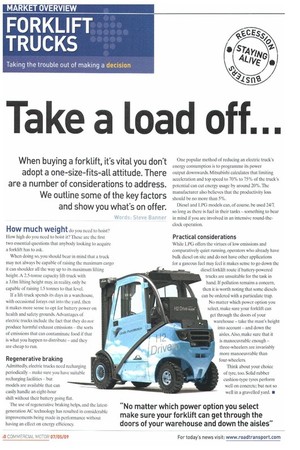Take a toad off...
Page 40

If you've noticed an error in this article please click here to report it so we can fix it.
When buying a forklift, its vital you don't adopt a one-size-fits-all attitude. There are a number of considerations to address. We outline some of the key factors and show you what's on offer.
Words: Steve banner How much weight do you need to hoist? How high do you need to hoist it? These are the first two essential questions that anybody looking to acquire a forklift has to ask.
When doing so, you should bear in mind that a truck may not always be capable of raising the maximum cargo it can shoulder all the way up to its maximum lifting height. A 2.5-tonne capacity lift-truck with a 3.0m lifting height may, in reality, only be capable of raising 1.5 tonnes to that level.
If a lift-truck spends its days in a warehouse, with occasional forays out into the yard, then it makes more sense to opt for battery power on health and safety grounds. Advantages of electric trucks include the fact that they do nol produce harmful exhaust emissions — the sorts of emissions that can contaminate food if that is what you happen to distribute — and they are cheap to run.
Regenerative braking
Admittedly, electric trucks need recharging periodically — make sure you have suitable recharging facilities — but models are available that can easily handle an eight-hour shift without their battery going flat.
The use of regenerative braking helps, and the latestgeneration AC technology has resulted in considerable improvements being made in performance without having an effect on energy efficiency. One popular method of reducing an electric truck's energy consumption is to programme its power output downwards. Mitsubishi calculates that limiting acceleration and top speed to 70% to 75% of the truck's potential can cut energy usage by around 20%, The manufacturer also believes that the productivity loss should be no more than 5`Ya.
Diesel and LPG models can, of course, be used 24/7, so long as there is fuel in their tanks — something to bear in mind if you are involved in an intensive round-theclock operation.
Practical considerations
While LPG offers the virtues of low emissions and comparatively quiet running, operators who already have bulk diesel on site and do not have other applications for a gaseous fuel may feel it makes sense to go down the diesel forklift route if battery-powered trucks are unsuitable for the task in hand. If pollution remains a concern, then it is worth noting that some diesels can be ordered with a particulate trap.
No matter which power option you select, make sure your forklift can get through the doors of your warehouse — take the mast's height into account — and down the aisles. Also, make sure that it is manoeuvrable enough — three-wheelers are invariably more manoeuvrable than four-wheelers.
Think about your choice of tyre. too. Solid rubber cushion-type tyres perform well on concrete; but not so well in a gravelled yard. •












































































































































